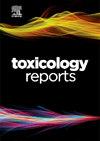Transplacental and genotoxicity effects of thallium(I) during organogenesis in mice
Q1 Environmental Science
引用次数: 0
Abstract
The increased concentration of thallium (Tl) in the environment is a cause for concern because the entire population, including pregnant women, is exposed, and this metal crosses the placenta and reaches the conceptus during development. In biological models such as mice, some abnormalities and delays in ossification occur in the fetuses of mice administered Tl on day 7 of gestation, but exposure to environmental Tl is constant during fetal development; therefore, in this study, the effects of several administrations of TI during organogenesis on the external morphology, skeletal development and genotoxicity of fetuses were evaluated. Four groups of 10 pregnant mice were administered 5.28, 6.16, 7.4 or 9.25 mg/kg body weight Tl(I) acetate intraperitoneally during fetal organogenesis. Additionally, samples were taken from fetuses from pregnant mice treated with 5.28 and 6.16 mg/kg body weight to evaluate the transplacental genotoxicity. The results revealed that the 9.25 mg/kg body weight dose produced maternal and fetal toxicity, and all of the treatment groups presented relatively high percentages of fetuses with external abnormalities, reduced bone ossification, and an increased percentage of liver cells with structural chromosomal aberrations (SCAs) and micronuclei (MNs) in blood cells. These results show that Tl(I) acetate administered during organogenesis produces abnormalities, including a delay in ossification and transplacental genotoxicity, in mouse fetuses. These findings are important because Tl has negative effects on development and may affect the health of offspring in the future because it can damage genetic material.
铊(I)在小鼠器官发生过程中的经胎盘和遗传毒性作用。
环境中铊(Tl)浓度的增加引起了人们的关注,因为包括孕妇在内的所有人都暴露在铊中,这种金属会穿过胎盘,在发育过程中到达胎儿体内。在小鼠等生物模型中,妊娠第7天给予Tl的小鼠胎儿出现一些异常和骨化延迟,但在胎儿发育过程中,暴露于环境Tl是恒定的;因此,在本研究中,我们评估了器官发生过程中不同剂量的TI对胎儿外部形态、骨骼发育和遗传毒性的影响。在胎儿器官发生期间,4组10只妊娠小鼠分别腹腔注射5.28、6.16、7.4和9.25 mg/kg体重的醋酸酯。此外,从5.28和6.16 mg/kg体重处理的妊娠小鼠的胎儿中提取样本,以评估经胎盘遗传毒性。结果显示,9.25 mg/kg体重剂量对母胎均产生毒性,且各治疗组胎儿外部异常比例较高,骨化程度降低,肝细胞结构染色体畸变(SCAs)和血细胞微核(MNs)比例增加。这些结果表明,在器官发生期间给药的醋酸酯会产生异常,包括小鼠胎儿骨化和经胎盘遗传毒性的延迟。这些发现很重要,因为Tl对发育有负面影响,并可能影响后代的健康,因为它会破坏遗传物质。
本文章由计算机程序翻译,如有差异,请以英文原文为准。
求助全文
约1分钟内获得全文
求助全文
来源期刊

Toxicology Reports
Environmental Science-Health, Toxicology and Mutagenesis
CiteScore
7.60
自引率
0.00%
发文量
228
审稿时长
11 weeks
 求助内容:
求助内容: 应助结果提醒方式:
应助结果提醒方式:


